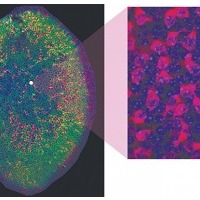The ability to hear and balance is in the roots.
Both depend on hair cells, small sensory cells in the inner ear. Damage of hair cells leads to the loss of these functions. Though lower vertebrates such as birds have the ability to replace these hair cells, mammals like humans do not.
Researchers from the UW’s Institute for Stem Cell and Regenerative Medicine (ISCRM) — in conjunction with Virginia Merrill Bloedel Hearing Research Center (VMBHRC) — are trying to solve mysteries related to mammals’ inability to regenerate damaged hair cells.
The loss of hair cells commonly occurs with age, though there are also injuries and diseases that might cause them to deteriorate, musicians and factory workers being some of the high-risk demographics due to their exposure to loud sounds.

Left: This confocal micrograph shows the whole utricle (balance organ) from an adult mouse. This organ has spontaneously regenerated a small number of its hair cells (red) after ablation of the vast majority of its hair cells. The cell-to-cell junctions at the surface of the sensory epithelium are shown in green. The blue label shows the extent of the organ.
“This is also something that’s very important to the college-age population if you’re exposed to loud sounds for long periods of time,” said Elizabeth Oesterle, research associate professor in otolaryngology-HNS who is also a researcher at VMBHRC. “For example if you’re listening with ear buds … listening to loud songs or sounds for many hours could cause some damage.”
In 2010, the National Institute on Deafness and Other Communication Disorders (NIDCD) estimates that approximately 15 percent of Americans between the ages of 20 and 69 experience hearing loss because of exposure to loud noises in their workplace or leisure activities.
Oesterle said that mammals, unlike birds, are born with a set number of hair cells, so the loss of those cells results in a permanent deficit.
Oesterle and her lab are currently studying the inner ear of the bird to observe the stimulating factors present in cell proliferation and differentiation. The results of those observations can then be used to develop ways to stimulate hair cell regeneration in mammals, including humans.
Other research areas can also be found within the study of hair cell deficit and hearing loss. Olivia Bermingham-McDonogh, associate professor of biological structure and VMBHRC researcher, is currently studying the developmental aspect of these hair cells by using mice as the primary model of study.
“We use mice because they have an inner ear that is very similar to the human inner ear,” Bermingham-McDonogh said. “The difference between mice and human inner ear is that mice don’t hear until they’re born … [whereas] humans can hear in utero.”
Bermingham-McDonogh said the difference gives the research team a developmental window through which they can see the development of the hair cells, both after the mice are born and embryonically. The lab samples the inner ear tissue at embryonic stages, then allows them to develop in cultures and observes the arrangement of cells when given drugs that either inhibit or activate pathways.
Another VMBHRC-affiliated research project is Jennifer Stone’s, research associate professor in otolaryngology-HNS and VMBHC researcher, who is currently trying to develop biological treatments for hearing and balance disorders and primarily focuses on adult damaged tissues.
“[We identify] signals that can promote hair cell progenitors to regenerate hair cells in the cochlea and balance organs,” Stone said. Her lab’s research methodologies include transgenic mice, molecular biology, cell and organ culture, and digital imaging.
These researchers have contributed to greater understanding of hair cell regeneration in mammals, with specific technical achievements in their respective fields. For now it is still unclear when their work will be translated into clinical applications. Stone said the research might take from 10 to 20 years before any therapeutic methods can be developed.
Bermingham-McDonogh said that though her lab has made strides in the last 10 years, translating methods that work on mice to be applicable to humans is challenging.
“I would say it’s hard to guess how long this would take because we don’t really know what kind of things we’re going to run into once we start putting factors into humans,” Bermingham-McDonogh said.
“We’re making good progress, but this is a tough problem,” Oesterle said. “We’re a ways away — there’s a lot of work to be done, [but] we’re working hard and we’re very hopeful.”
Not only is the structure of the inner ear small and delicate, it is also buried within the temporal bone; one of the biggest challenges within this research field is successfully accessing a minuscule part of the body to work with.
On top of that, these researchers also face the unpredictability of acquiring funding. When they face budget cuts, they have to cut some research team members, making it hard to keep up the momentum of the research.
“You have to have the dollars to run a lab and do the experiments,” Oesterle said.
Though these researchers still have various obstacles to overcome, they feel the result will be highly useful for the public.
“With your sense of hearing, you live in the center of the world … and our sense of balance clearly is essentially important, but we take for granted because we don’t notice it till it goes wrong,” Bermingham-McDonogh said. “Clearly there’s a clinical need [for this research], and as the population ages, that need [will become] bigger and bigger.”
Taken from https://dailyuw.com/archive/2013/02/27/science/uw-researchers-split-hairs#.UUvRdBxQHDm.

